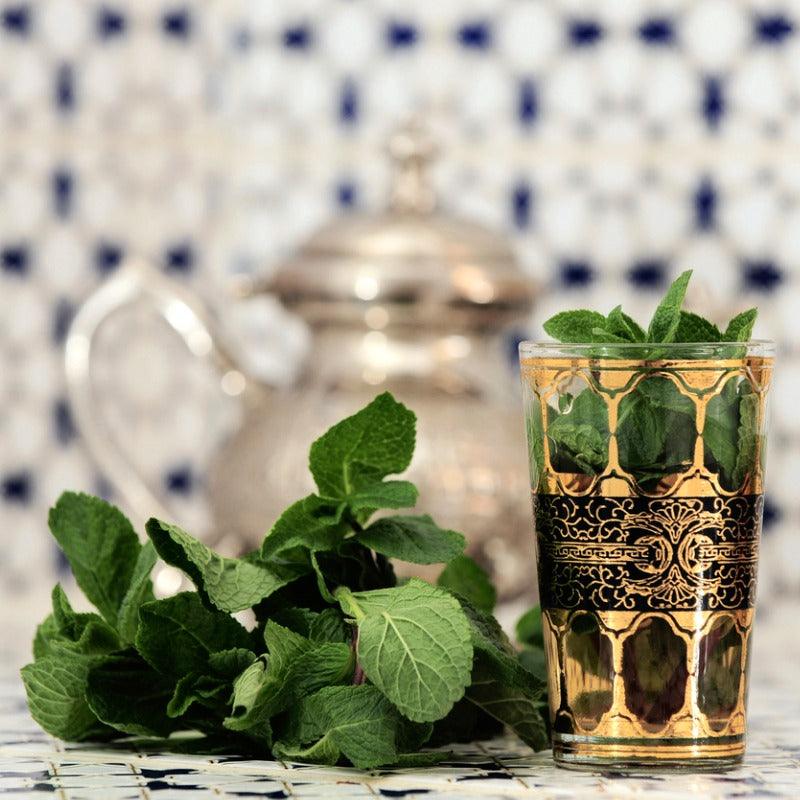Item Number: PV212
Organic Moroccan Mint (1 Gallon)
Serrated green leaves, purple edible blooms
Moroccan Mint, an enduring, bushy, and versatile perennial herb, is a cherished plant with a rich history. Known scientifically as Mentha spicata var. crispa 'Moroccan', this variety of spearmint is widely cultivated for its culinary and medicinal uses. With soft stems, densely packed green leaves with serrated edges, and purple-hued edible blossoms during the summer and autumn, Moroccan Mint is both a visual and aromatic delight. The intense spearmint flavor of its leaves, whether fresh or dried, makes it a key ingredient in numerous dishes and beverages, particularly the iconic Moroccan mint tea.
Growing Moroccan Mint
Growing Moroccan Mint is relatively straightforward, making it an ideal choice for both novice and experienced gardeners. Here are some essential aspects to consider:
Light Requirements: Moroccan Mint thrives in full sun to partial shade. For optimal growth, it should receive at least 4-6 hours of sunlight daily. While it can tolerate some shade, too much can lead to leggy growth and diminished flavor intensity.
Soil Preferences: This mint variety prefers moist, well-drained soil with a slightly acidic to neutral pH. Rich, loamy soils are ideal, but Moroccan Mint is adaptable and can grow in various soil types as long as they provide good drainage.
Watering Needs: Consistent moisture is crucial for Moroccan Mint. The soil should be kept evenly moist but not waterlogged. During hot, dry periods, additional watering may be necessary to maintain optimal growth. Mulching around the base of the plants can help retain soil moisture and suppress weeds.
Planting Tips: When planting, space the plants about 12-18 inches apart to allow for adequate air circulation and prevent overcrowding. Since Moroccan Mint spreads via underground stems, consider planting it in pots or containers to control its growth and prevent it from overtaking other garden areas.
Maintenance
Regular maintenance is essential to keep Moroccan Mint healthy and productive:
Pruning: Regular pruning is crucial to maintain a tidy appearance and promote bushier growth. Pinch back the tips of the stems regularly to encourage branching. Additionally, removing flower buds as they appear will keep the plant focused on leaf production, enhancing its flavor and aroma.
Fertilization: Moroccan Mint is not particularly demanding in terms of fertilization. A balanced, all-purpose fertilizer applied in early spring can provide the necessary nutrients for healthy growth. Avoid over-fertilizing, as this can lead to excessive foliage at the expense of flavor.
Pest and Disease Management: Moroccan Mint is relatively pest-resistant but can occasionally suffer from aphids, spider mites, and mint rust. Regular inspection and prompt action at the first sign of trouble can help keep these issues in check. Using organic insecticidal soap or neem oil can effectively control pests without harming beneficial insects.
Harvesting and Storage
Harvesting: Moroccan Mint can be harvested as soon as the plant has several sets of leaves. For the best flavor, harvest the leaves in the morning after the dew has dried but before the heat of the day. Regular harvesting encourages continuous growth throughout the growing season.
Storage: Fresh Moroccan Mint leaves can be stored in the refrigerator for a few days. For longer storage, the leaves can be dried or frozen. To dry, hang small bunches of mint upside down in a dark, well-ventilated area until the leaves are crumbly. Alternatively, mint leaves can be frozen by placing them in a single layer on a baking sheet, freezing them, and then transferring them to a freezer bag.
Uses of Moroccan Mint
Moroccan Mint is not only valued for its growth but also for its myriad uses in the kitchen and beyond.
Moroccan Mint Tea: Moroccan mint tea is a popular beverage in Morocco. It is not just meant for drinking; it is meant for sharing and is a symbol of hospitality and family in Morocco. Moroccan Mint is steeped along with a Chinese green tea referred to as 'gunpowder' tea and sugar. Once steeped, the tea is poured from a great height into glass cups to be enjoyed throughout the day and especially when one has visitors. There is a ritual to the making of Moroccan green tea, and it is highly regarded as part of the Moroccan culture. During various times throughout the year, other herbs are added to the tea to aid in maintaining good health and to be used as a kind of medicinal tea.
Culinary Uses: Moroccan Mint's sweet, mild flavor makes it a versatile herb in the kitchen. It can be added to salads, sauces, marinades, and desserts to impart a fresh, aromatic touch. Mint is also a key ingredient in traditional dishes such as tabbouleh and mint yogurt sauce.
Popular Moroccan Mint Recipes:
- Moroccan Mint Tea: Steep a handful of fresh Moroccan Mint leaves in hot water for 5-10 minutes. Add sugar or honey to taste. Serve hot or chilled for a refreshing beverage.
- Mint Yogurt Sauce: Combine chopped Moroccan Mint leaves with plain yogurt, minced garlic, lemon juice, salt, and pepper. This sauce pairs well with grilled meats, vegetables, and as a dip.
- Tabbouleh: Mix finely chopped Moroccan Mint leaves with bulgur wheat, diced tomatoes, cucumbers, parsley, lemon juice, olive oil, salt, and pepper for a refreshing and nutritious salad.
Growing Moroccan Mint Indoors
For those without garden space, growing Moroccan Mint indoors is a viable option.
Container Selection: Choose a pot with adequate drainage holes. Moroccan Mint's spreading nature makes it well-suited for containers.
Indoor Light Requirements: Place the pot in a location where it will receive plenty of sunlight. A south-facing window is ideal. If natural light is insufficient, consider using grow lights to supplement.
Watering Indoors: Indoor mint plants need regular watering to keep the soil moist. Be careful not to overwater, as this can lead to root rot.
Pruning and Maintenance: Just like outdoor plants, indoor Moroccan Mint requires regular pruning to maintain a healthy, bushy appearance. Pinch back new growth to encourage a fuller plant.
Conclusion
Growing Moroccan Mint offers a range of benefits, from enhancing your culinary creations to providing a fresh, aromatic element to your garden or home. Whether you choose to grow it outdoors or indoors, this versatile herb is relatively easy to cultivate and maintain. Its historical significance and cultural importance, particularly in Moroccan tea traditions, add to its charm. For those interested in starting their own mint patch, Moroccan Mint for sale is widely available at garden centers and online retailers. By following the guidelines outlined above, you can enjoy a thriving mint plant and the delightful flavors it brings to your kitchen. Whether you're brewing a pot of traditional Moroccan Mint tea or adding a fresh twist to your favorite recipes, this aromatic herb is sure to enhance your culinary adventures.
Visit our Berry, Vine & Crowns Characteristics Chart to compare growing characteristics for all our berries, vines, and crowns.

Check Your Zone Compatibility:
Compatible with your zone.
Growing Zone for

Our Guarantee To You
Since 1976, we've served our customers at every stage of growing. Please contact us at any time. We are happy to support and assist you.
Shipping Information
Shipping Information
Shipping Weight: 5.0 lb
Features
Features
- Attracts Bees/Butterflies
- Attracts Hummingbirds
- Container Compatible
- Does Not Require Support
- Edible Flower
- Fragrant
- Good for Drying
- Heirloom
- Open-Pollinated
- Plant Spreads
- Requires Summer Water
Characteristics
Characteristics
Planting & Care
Planting & Care
Useful Information
Useful Information
Guarantee
Guarantee
We guarantee the perishable items we sell to be in good, viable condition when we sell them. Perishable items include, but are not limited to, garlic bulbs, flower bulbs, seed potatoes, onion sets & transplants, potted or bare root trees, vegetable crowns, etc. If your perishable item arrives in substandard condition, take photographs and please contact us within 3 days of the purchase date (or delivery date) and we will provide you with a refund of the purchase price (excluding shipping costs), or a replacement. Accordingly, we urge you to open any boxes marked as ""Perishable"" immediately upon receiving them and inspect the shipment thoroughly (do not crack open heads of garlic, we do not accept claims on cracked garlic). Because some perishable items can deteriorate very quickly, we cannot accept any claims beyond the 3-day time frame as it becomes too difficult to determine if these items were delivered in substandard condition, or if they turned into such substandard condition because of having been improperly cared for or stored once delivered.
Share


They looked good when the plants arrived. Waiting for planters to transplant so they'll have more room, but not planting in the garden to avoid the mint from spreading all over. They're still alive....


